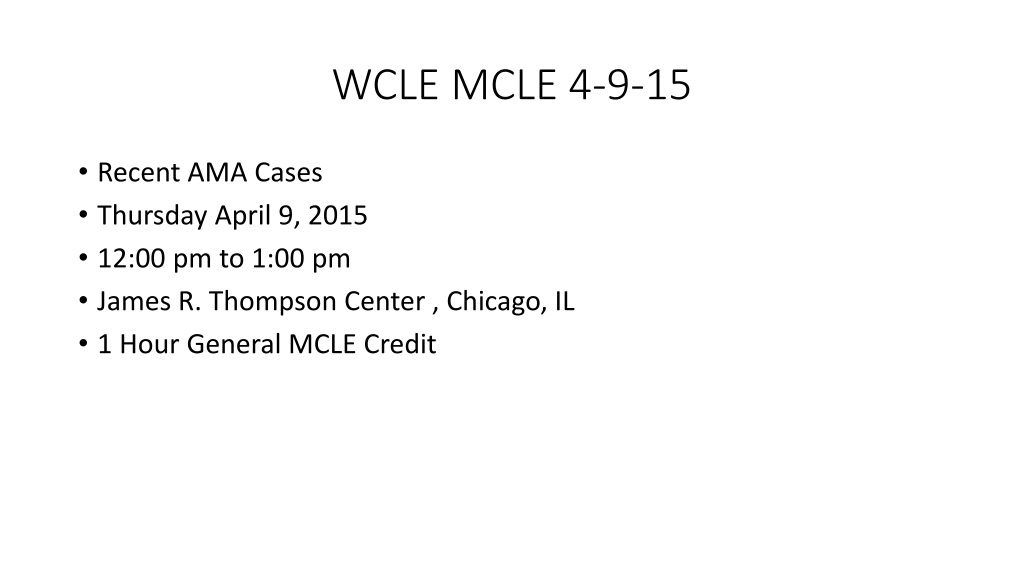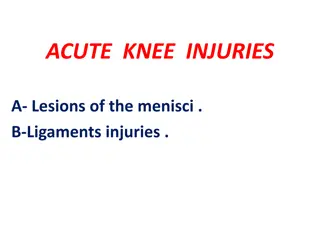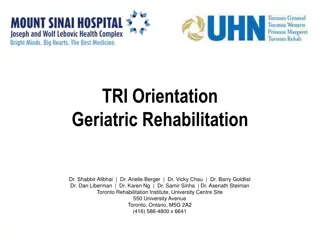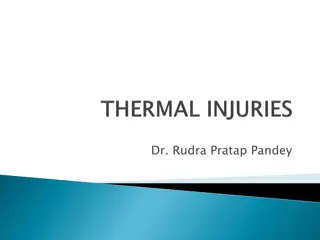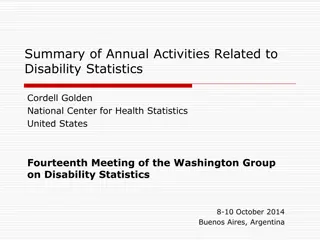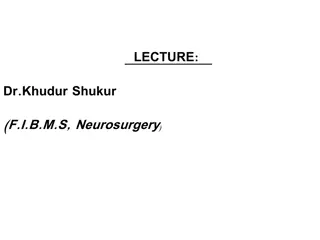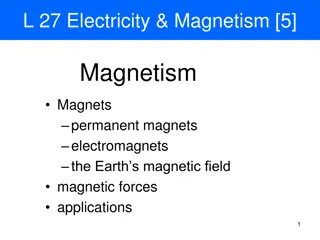Determination of Permanent Partial Disability in Work-Related Injuries
Criteria for establishing permanent partial disability in work-related injuries occurring after September 1, 2011 include medical impairment reports, evaluation based on specific measurements, consideration of factors such as occupation and future earning capacity, and the use of the American Medical Association's guides. This determination process involves a comprehensive assessment to ensure fair evaluation and compensation based on the severity of impairment and its impact on the individual's ability to work effectively.
- Disability determination
- Work-related injuries
- Medical impairment reports
- American Medical Association
- Compensation evaluation
Download Presentation

Please find below an Image/Link to download the presentation.
The content on the website is provided AS IS for your information and personal use only. It may not be sold, licensed, or shared on other websites without obtaining consent from the author. Download presentation by click this link. If you encounter any issues during the download, it is possible that the publisher has removed the file from their server.
E N D
Presentation Transcript
WCLE MCLE 4-9-15 Recent AMA Cases Thursday April 9, 2015 12:00 pm to 1:00 pm James R. Thompson Center , Chicago, IL 1 Hour General MCLE Credit
Section 8.1b 820 ILCS 305/8.1b Sec. 8.1b. Determination of permanent partial disability. For accidental injuries that occur on or after September 1, 2011, permanent partial disability shall be established using the following criteria: (a) A physician licensed to practice medicine in all of its branches preparing a permanent partial disability impairment report shall report the level of impairment in writing. The report shall include an evaluation of medically defined and professionally appropriate measurements of impairment that include, but are not limited to: loss of range of motion; loss of strength; measured atrophy of tissue mass consistent with the injury; and any other measurements that establish the nature and extent of the impairment. The most current edition of the American Medical Association's "Guides to the Evaluation of Permanent Impairment" shall be used by the physician in determining the level of impairment. (b) In determining the level of permanent partial disability, the Commission shall base its determination on the following factors: (i) the reported level of impairment pursuant to subsection (a); (ii) the occupation of the injured employee; (iii) the age of the employee at the time of the injury; (iv) the employee's future earning capacity; and (v) evidence of disability corroborated by the treating medical records. No single enumerated factor shall be the sole determinant of disability. In determining the level of disability, the relevance and weight of any factors used in addition to the level of impairment as reported by the physician must be explained in a written order.
Frederick Williams v. Flexible Staffing 11WC046390; 13IWCC0557;13L50595;14IWCC0576 Facts DA 10-7-11 45 year old welder grabs for 400 lb rail Right distal biceps tendon rupture Dr. Aribindi performs surgery RTW full duty, despite complaints; no job Dr. Mark Levin does AMA impairment rating: 6% UEI; 4% WPI Arbitrator s Decision: 30% arm; reduced by IWCC to 25% arm Respondent s Circuit Court Review: Remanding-Ord (2-13-14 Re-Arbitration Allowed ) 14 IWCC 0576: Corrected Decision & Opinion On Remand (7-22-14): 25% loss of use of the Right Arm 8-15-14 Respondent files Circuit Court Review
Frederick Williams v. Flexible Staffing 14 IWCC 0576 (On Remand) On remand the Commission makes the following clarification to support its conclusion, modifies the Decision of the Arbitrator as stated below and otherwise affirms and adopts the decision of the Arbitrator. We understand Respondent's argument that Dr. Levin's A.M.A. impairment rating of 6% of the upper extremity was not given enough weight by the Arbitrator. However, we do not agree with the great weight that Respondent wants placed on this rating because to do so would be to disregard the other factors and give them no weight at all. Section 8.1b of the Act requires the consideration of five factors in determining permanent partial disability. Section 8.1b also states, "No single factor shall be the sole determinant of disability. In determining the level of disability, the relevance and weight of any factors used in addition to the level of impairment as reported by the physician must be explained in a written order." We initially note that the term "impairment" in relation to the A.M.A. rating is not synonymous with the term "disability" as it relates to the ultimate permanent partial disability award.
Frederick Williams v. Flexible Staffing 14 IWCC 0576 Based on the above, the Commission finds that the 6% impairment rating by Dr. Levin does not adequately represent Petitioner's actual disability in this case. When considering the other four factors, we find that Petitioner's permanent partial disability is 25% loss of use of the right arm. The Commission modifies the Arbitrator's Decision, to decrease Petitioner's partial disability award from 30% to 25% loss of use of the right arm pursuant to Section 8(e) of the Act. Discussion of other factors: Maybe next time
October 2014 AMA Cases Todd Booten v. SOI DOT, 14IWCC0837, 10/03/2014, No AMA Guides, Award modified down to 12.5% leg from 20% Henry Taylor v. City of Chicago, 14IWCC0838, 10/06/2014, No AMA Guides, Award of additional 7% leg (25% prior credit) affirmed Fabiola Fernandez v. Dart Container, 14IWCC0843, 10/06/2014, No AMA Guides, Award 50% right thumb affirmed (statutory amputation) Steven Hand v. Illinois Cement, 14IWCC0857, 10/06/2014, No AMA Guides, DA s 5/5/09 & 10/28/09?, 20% leg on remand, 8.1b analysis used
October 2014 AMA Cases Edna Murphy v. WalMart, 14IWCC0874, 10/08/2014, No AMA Guides, Award of 10% each hand affirmed Anthony Jones v. City of Chicago, 14IWCC0880, 10/06/2014, Award modified down to 22.5% from 25% leg (Both parties got AMA?) Terina Green v. PPG Industries, 14IWCC0912, 10/24/2014, Award 17.5% whole person affirmed, AMA 5% UEI, Award 17.5% whole person (34.6% arm) affirmed Joshua Gochanour v. Eichenauer Services, 14IWCC0929, 10/29/2014, Award of 17.5% thumb modified up to 25%
Anthony Jones v. City of Chicago 12WC037009; 14IWCC037009 The Decision of the Arbitrator was filed with the Illinois Workers' Compensation Commission on March 14, 2014, and, in said decision, Arbitrator Mason concluded Petitioner lost 25% use of his left leg due to injuries sustained to his left knee on August 22, 2012. In arriving at her decision, the Arbitrator applied the criteria for determining permanent partial disability as is set forth in Section 8.1b of the Act. The Commission takes no issue with the conclusions arrived at by the Arbitrator in her application of Section 8.1b with the exception to the evidence of disability corroborated by the treating medical records. The Commission, in reviewing Petitioner's medical records and testimony and comparing the two, finds Petitioner engaged in embellishment. The Commission notes Petitioner's complaints were more pronounced when he was examined by Dr. Michael Gross, his choice for an AMA examination, and by Dr. Shane Nho, Respondent's AMA examiner, than they were when he was examined by his own treating physician, Dr. Michael Maday, and his physical therapists at ATI. The Commission also notes the two complaints Petitioner testified to having outside of work, not being able to ride a bicycle and having to avoid picking up his granddaughter, are not found in his medical records. The Commission takes the position that Petitioner was more forthcoming concerning the true condition of his left knee with Dr. Maday and physical therapists than he was with Dr. Gross, Dr. Nho or the Arbitrator and, in doing so, finds his left knee not be as permanently disabled as did the Arbitrator. Accordingly, the Commission reduces the permanent partial disability award by 2 1/2%, finding Petitioner sustained a 22 1/2% loss of use of his left leg.
Terina Green v. PPG 12WC035460; 14IWCC0912 1. The level of impairment: Dr. Atluri furnished multiple impairment evaluation reports. Most important is his last one which was based upon Petitioner having finally reached maximum medical improvement. Dr. Atluri found Petitioner's complaints to be credible at that time and he concluded her impairment was nine percent of the upper extremity or five percent of a whole person. Petitioner's Quick Dash score was 56.8 which he testified was at the higher end of moderate in terms of severity. Dr. Atluri testified that while a normal rotation is between sixty-five to ninety degrees, Petitioner's external and internal rotation was about forty degrees. Dr. Atluri added that an elevation or flexion of the arm is typically 165 degrees, but Petitioner's score was 125 degrees. Dr. Atluri also testified that Petitioner had loss of motion in those three ranges and that Petitioner also had some weakness secondary to some pain or discomfort, as well as some pain with a cross arm maneuver. Dr. Atluri testified that it was significant that on March 18, 2013, Petitioner still had a bit of residual tenderness in her left shoulder, her left shoulder motion was not normal, she had some stiffness, and loss of rotation as well as loss of elevation. Dr. Atluri testified that Petitioner may have some minor improvements in her motion, but that he did not expect significant improvement in the future. Finally, Dr. Atluri added that Petitioner has deficits in all ranges of motion and will continue to have deficits on a permanent or indefinite basis. The Arbitrator gives considerable weight to this factor. 2. Petitioner's Occupation: Petitioner's occupation at the time of the accident was that of a factory worker. She had performed those duties for approximately six years prior to her accident. At the time of arbitration Petitioner was unemployed as her last employer, G & D Integrated, had shut down. Petitioner voluntarily left her employment with Respondent to work for G & D. The job for G & D was supervisory in nature and, by Petitioner's description, less physical than her job for Respondent. Petitioner is left hand dominant. No direct evidence was presented to show that Petitioner's current unemployment status is attributable to her work injury. How ever, based upon Petitioner's credible explanation of her former job duties for Respondent, the Arbitrator reasonably infers that it would be challenging for Petitioner to engage in that type of factory work in light of her injury.
Terina Green v. PPG 12WC035460; 14IWCC0912 3. Petitioner's Age: Petitioner was thirty-nine years old at the time of her accident. No direct evidence was presented by either party as to how Petitioner's age impacts any disability. However, the Arbitrator notes that Petitioner may reasonably be expected to live and work with the effects of her injury for a longer time than an older individual and, therefore, her permanent partial disability may be greater than that of an older individual. 4. Future Earning Capacity: No evidence was presented as to how Petitioner's future earning capacity was affected by her injury. While Petitioner testified to a reduction in pay after her accident, she did not prove by a preponderance of the evidence that the reduction was related to her injury. 5. Evidence of Disability Corroborated in the Treating Records: Petitioner's records from her treating physicians have demonstrated evidence of disability. Petitioner underwent surgery to her left shoulder which included a subacromial decompression, rotator cuff repair (for an 80% tear), a proximal biceps tenodesis, and intra-articular evaluation, debridement, and removal of loose bodies. While surgery improved Petitioner's condition and she was released with no restrictions, she has continued to notice limitations in her left arm and shoulder. Post-operatively the records of Dr. Smith and the physical therapist show ongoing pain and stiffness in Petitioner's left arm and shoulder. Additionally, while there is no treating record to corroborate Petitioner's testimony regarding her visit and procedure with Dr. Smith on June 4, 2013, the Arbitrator notes Dr. Smith's multiple notations and comments concerning scar tissue and adhesions in earlier visits.
Terina Green v. PPG 12WC035460; 14IWCC0912 Petitioner's testimony concerning her injury and her ongoing symptoms and complaints was credible. Even Respondent's impairment rating physician, Dr. Atluri, found her complaints and responses during their last examination credible. In light of Section 8(b) 1 of the Act and after considering the foregoing factors, the Arbitrator concludes that Petitioner has suffered a loss of 17.5% of a person as a whole as a result of her work accident. As Petitioner's injury is primarily to her left shoulder, an award under 8(d)1 is appropriate pursuant to Will County.
Joshua Gochanour v. Eichenauer Services 11WC049129; 14IWCC0929 First, the Respondent submitted an AMA impairment rating of 10% of the thumb, which was determined by Dr. Brower. The Petitioner did not submit an AMA impairment rating into evidence. In making his determination, Dr. Brower noted complaints of decreased sensation along the left radial thumb, no atrophy, normal range of motion other than inability to extend the IP joint past zero degrees, and normal strength. Sensory testing verified partial loss of sensation at the radial aspect of the thumb. Petitioner's occupation was a server/waiter. While he complained subjectively of problems doing his job subsequent to the accident, his medical records, other than Dr. Nord's, appear to indicate he was having no significant problems doing his job. Dr. Nord noted that Petitioner continued to have left thumb pain after returning to work, and after a few months left to take a different job. We note that the ER report from Advocate Bromenn and the report of Dr. Brower indicated the Petitioner is right handed, so this injury was to his non-dominant hand. At the same time, being that the injury was to the thumb, any impairment was to a digit that is important to gripping.
Joshua Gochanour v. Eichenauer Services 11WC049129; 14IWCC0929 The Petitioner returned to employment at approximately 33 years of age. Dr. Tattini noted in his last report of September 15, 2012 that he hopes Petitioner's ongoing sensation problems will continue to improve over time. Petitioner testified that it hadn't improved at the time of the hearing date. Dr. Nord reported that he believed Petitioner may sustain increasing discomfort in the area of the laceration as he gets older. No evidence was presented by either party that indicates real or possible impact from the injury on the Petitioner's future earning capacity. With regard to the factor involving evidence of disability corroborated by the medical records, the Petitioner's continued complaints of a lack of sensation in the radial nerve of the thumb are supported by his treating records, as well as the report of Dr. Brower. While he testified to a lack of strength, this does not seem to be corroborated by the medical, as the physical therapy records and last notes of Dr. Tattini indicate essentially normal strength. Dr. Brower, Respondent's examining physician, did note a small loss of range of motion with regard to IP joint extension. Dr. Nord's June 25, 2013 report supports some ongoing weakness of the left thumb.
Joshua Gochanour v. Eichenauer Services 11WC049129; 14IWCC0929 The Commission believes that, based on a review of the surgical report, this case involves a relatively significant thumb injury with nerve repair. There was no evidence of significant tendon or bone injury. There was evidence of ongoing problems with radial sensation. The Commission takes into account the AMA rating and the lack of evidence presented with regard to earning capacity. However, in this particular case, we give more weight to the fact that Petitioner has corroborated complaints regarding an ongoing lack of sensation and some lack of strength, that he will have to live with this injury and its sequelae for a significantly longer time than an older worker, and that he testified to difficulty in returning to his normal job due to the injury. Based on this and a review of prior precedent regarding similar injuries, the Commission declines the Petitioner's request to increase the award to 35% of the left thumb, but does increase it from the Arbitrator's award of 17.5% of the left thumb to 25% of the left thumb.
November 2014 AMA Cases Douglas Coffey v. State of Illinois/Menard, 14IWCC0991, 11/19/2014, No AMA Guides, Award 12.65% MAW (25% arm) Steve Maynard v. Danville Housing Authority, 14IWCC0992, 11/19/2014, AMA 6% UEI, Award 17.5% MAW (or 34.6% arm) Jacqueline Camacho v. Bar Toma, 14IWCC0994, 11/21/2014, No AMA Guides, Award 22.5% MAW Stormy Monday v. Caterpillar, 14IWCC1002, 11/24/2014, AMA 6% WPI, Award 15% MAW David Sharpe v. Lakeland Com. Coll., 14IWCC1006, 11/24/2014, AMA 5% UEI, Award 22.5% arm Juan Carlos Alvia (Aliva?) v. Country Club Hills PD, 14IWCC1028, 11/25/2014, AMA 5% LEI, Award of 7.5% foot modified up to 12.5% Kevin Klein v. Dynegy, 14IWCC1030, 11/26/2014, No AMA Guides, Award 17.5% leg
Douglas Coffey v. State of Illinois/Menard 14IWCC0991 29 year old correctional officer Right rotator cuff tear and impingement syndrome & labral tear Award 12.65% MAW (25% arm equivalent); Affirmed & adopted unanimously Petitioner s date of accident is after September 1, 2011, and therefore Section 8.1b of the Act shall be discussed concerning the PPD award being issued. It is noted when discussing the permanency awrd being issued that no PPD impairment report pursuant to Sections 8.1b(a) and 8.1b(b)(i) of the Act was offered into evidence by either party. This factor is hereby waived. (emphasis added)
Steve Maynard v. Danville Housing Authority 14IWCC0992 The Commission, after considering the issues of the nature and extent of petitioner's disability, and whether the award should be based on 8(e) or 8(d)2 of the Act and being advised of the facts and law, affirms and adopts the Decision of the Arbitrator, which is attached hereto and made a part hereof (17.5% MAW; subacrominal decompression & rotator cuff repair) Petitioner was judged by Respondent's medical evaluator to have a six percent (6%) AMA impairment rating of the upper extremity. Seven percent (7%) impairment of the arm is the maximum impairment rating available in cases of full thickness rotator cuff tears. The Arbitrator has some issues with me impairment rating found by Dr. Katz. The rating is premised on the Petitioner having a normal range of motion in the right shoulder. In his exam, Dr. Katz reported such a finding. However, it appears from the report, Dr. Katz only tested the Petitioner's right shoulder. The AMA Guides require the examiner to test both shoulders so as to accurately determine what is normal for each individual. See AMA Guide, Sixth Edition, Section 15.7 (a), p. 461. More importantly. Dr. Katz' numbers are inconsistent with those found on several occasions by Dr. Rotman, who did examine both shoulders. On January 28, 2013, Dr. Rotman found 140 degrees of flexion and abduction of me right shoulder and 150 on the left. He found 45 degrees of external rotation on the right shoulder and 60 degrees on the left. The Arbitrator cannot see how Dr. Katz was able to produce 180 degrees of flexion and 90 degrees of external rotation during his exam. Those numbers greatly exceed those found by Dr. Rotman on the Petitioner's good arm. Dr. Katz' range of motion findings are suspicious for the above reasons. The impairment rating used presumes a normal range of motion. For those reasons, the Arbitrator places very little weight on the rating.
Jacqueline Camacho v. Bar Toma 14IWCC0994 The Commission, after considering the issues of accident, medical expenses, temporary total disability, permanent partial disability, maintenance, and being advised of the facts and law, affirms and adopts the Decision of the Arbitrator, which is attached hereto and made a part hereof The Arbitrator considers the factors set forth in Section 8.1b of the Act, noting that neither party offered an AMA impairment rating into evidence. The Arbitrator, having considered the treatment records, Dr. Phillips' opinions, the functional capacity evaluation, Petitioner's chosen occupation and relatively young age and Petitioner's testimony, finds that Petitioner is permanently partially disabled to the extent of 22.5% loss of use of the person as a whole, equivalent to 112.5 weeks of compensation, under Section 8(d)2.
Stormy Monday v. Caterpillar 12WC024136; 14IWCC1002 The Commission, after considering the issues of accident, temporary total disability, permanent partial disability, medical expenses, and being advised of the facts and law, affirms and adopts the Decision of the Arbitrator, which is attached hereto and made a part hereof. (15% MAW, hemilaminectomy) 1. The level of impairment pursuant to the AMA Guidelines. Dr. Stephen Weiss examined Petitioner on behalf of Respondent on October 18, 2012 and July 1, 2013. On July 1, 2013, Dr. Weiss issued an impairment rating of 6% of the whole person. Dr. Weiss testified he rated Petitioner on spinal stenosis with a resolved radiculopathy that he did not think was work related. The Arbitrator found Dr. Weiss' opinions to be suspect as noted in "F" above. Petitioner was examined by Dr. Weiss on October 12, 2012, This examination was at the request of Respondent. Dr. Weiss felt the history of accident was consistent, and felt he suffered an aggravation of a degenerative back condition, which he felt resolved after a short period of time. Dr. Weiss did not indicate where he received information that the condition resolved itself and when. Dr. Weiss felt surgery was not warranted and related to this accident, and diagnosed pre-existing degenerative disc disease, symptom magnification, and prior back problems in 2010. Dr. Weiss did admit the 2010 injury resulted in a short period of treatment, and there was no evidence of on going symptoms prior to June 9, 2012. Dr. Weiss based his symptom magnification opinion on a negative straight leg raising test. The Arbitrator notes with interest that Petitioner was hired 6 months before this accident following a pre-employment physical examination that indicated no back symptoms or problems,
Stormy Monday v. Caterpillar 12WC024136; 14IWCC1002 2. Petitioner's occupation. Petitioner was employed by Respondent as a painter. His job entailed painting transmissions and drive train. 3. Petitioner's Age. Petitioner was 58 years of age at the time of the injury. 4. The Employee's Future Earning Capacity. Petitioner testified he had significant relief of his pain symptoms subsequent to his back surgery, however he still experiences pain in his lower back. Petitioner testified he is 80% better than before surgery. Petitioner was deemed a supplemental employee at the time of the injury by Respondent and was terminated while awaiting medical treatment. 5. Evidence of Disability. Petitioner's treating orthopedic surgeon, Dr. Mulconrey, testified he performed a foraminotomy, partial fasciatomy, and a hemilaminotomy at L4-L5 and L5-S1. Dr. Mulconrey testified Petitioner's incident at work was consistent with the symptoms he experienced in his lower back and right lower extremity. Dr. Mulconrey released Petitioner to perform full duty work on April 17, 2013. The Arbitrator has taken all of the factors listed above in consideration and finds Petitioner is entitled to receive an award from Respondent of 15% disability to his man or person as a whole under Section 8(d)2 of the Act. Based further upon the above, the Arbitrator finds the above conditions of ill-being to now be permanent in nature.
David Sharpe v. Lakeland Com. Coll. 14IWCC1006 The Commission, after considering the issues of the nature and extent of Petitioner's permanent partial disability, and the "interpretation of section 8.1b," and being advised of the facts and law, modifies the Decision of the Arbitrator as stated below and otherwise affirms and adopts the Decision of the Arbitrator, which is attached hereto and made a part hereof. The Arbitrator awarded Petitioner 22.5 % loss of the use of the left arm. In determining Petitioner's permanent partial disability, the Arbitrator noted that the AMA rating of 5% impairment was valid, Petitioner's vocation of carpenter requires the active use of both arms, he was 51 years old and would have to live with the disability for the rest of his life, there was no evidence of any loss of earning potential, the injury required surgery including the use of a surgical screw, and both Dr. Maender and Petkovich found reduced range of motion and Dr. Petkovich found a toss of muscle mass. The Commission notes that Dr. Maender released Petitioner to full duty construction-type work within about 2 1/2 months of surgery and Petitioner was able to return to his previous job activities for 15 months. He did not show any loss of earning potential, eventually left employment voluntarily, and is not seeking future employment. Everybody, including Petitioner, all agreed that he had an excellent outcome from his surgery. In assessing the record as a whole, the Commission finds that an award of 17.5% loss of the use of the left arm is appropriate in this case and modifies the award of the Arbitrator accordingly. Finally, the Commission notes that Respondent has already paid all reasonable and necessary medical expenses and temporary total disability benefits. Arbitrator: Petitioner did not submit an AMA impairment rating so the only AMA impairment rating is that of Dr. Petkovich. The Arbitrator finds that the AMA impairment rating of Dr. Petkovich is valid; however, the Arbitrator does note that impairment is not the equivalent of disability.
Juan Carlos Avila v. Country Club Hills PD 14IWCC1208 The Commission, after considering the issue of permanent disability and being advised of the facts and law, modifies the Decision of the Arbitrator as stated below and otherwise affirms and adopts the Decision of the Arbitrator, which is attached hereto and made a part hereof. Arbitrator Kane, after taking into consideration the enumerated factors as listed in Section 8.1(b) of the Act, found Petitioner sustained a 7.5% loss of use of the right foot as a result of the March 31, 2012, accident. Petitioner appealed Arbitrator Kane's arbitration decision, arguing his injury merited a larger permanency award. The Commission agrees. After reviewing the arbitration decision against the evidence, the Commission finds Arbitrator Kane erred when he found Petitioner had no complaints after returning to work concerning his right foot. Petitioner credibly testified he now wears boots to maintain stability in his right ankle as well as experiencing swelling in his ankle on more strenuous days, stiffness in his ankle when it is kept in the same position for a prolonged period of time, such as when he drive a patrol car. Also credibly testified to was Petitioner's need to medicate with Ibuprofen several times a week as well as his having to change certain aspects as to how he performs his duties as a police officer due to the residual effects of the March 31, 2012, accident. In recognition of Petitioner's lingering pain and functional deficits, the Commission finds Petitioner has experienced a 12 1/2% loss of the use of his right foot. Arbitrator: (i) the reported level of impairment per the AMA Guide is 5% of the right foot ) Dr. Lee gave his opinions on impairment in his report dated September 19, 2013. (Res. Ex. 17) Dr. Lee opined that Petitioner has a 5% lower extremity impairment under the AMA guides.)
Kevin Klein v. Dynegy 14IWCC1030 The Commission, after considering the issues of accident, causal connection, medical expenses, temporary total disability and permanency, and being advised of the facts and law, reverses the Decision of the Arbitrator, for the reasons stated below. 1) The reported level of impairment pursuant to the AMA Guidelines. The parties did not provide an impairment rating for the right knee. As such, this factor does not influence the permanent partial disability determination. Based on the five factors outlined in the Act, we find that Petitioner is entitled to 17.5% loss of the right leg. He sustained an acute partial medial meniscus tear, which was repaired, and following rehabilitation, Petitioner failed to report any major issues. While he still experiences weakness in his right knee, has trouble lifting himself up, and pain with certain weather, his final examination was normal and he has continued to work in the same job as he had before the accident with no evidence of a diminution of wages.
December 2014 AMA Cases Jeremiah Leibendorfer v. City of Bloomington, 14IWCC1064, 12/09/2014, AMA 4% UEI, Award 10% whole person (19.8% arm) affirmed Jerry Pratt v. Vactor Manufacturing, 14IWCC1080, 12/12/2014, No AMA Guides, Award 5% leg affirmed Andrezj Gornicki v. Halina s, 14IWCC1081, 12/12/2014, AMA 8% WPI, Award of 35% each hand + 5% whole person + 3 weeks disfigurement modified to 20% left hand + 25% right hand + 3 weeks disfigurement Robert Czuprynski v. Continetnal Tire, 14IWCC1100, 12/15/2014, AMA 3% UEI?, Award 25% hand affirmed Derek Flatt v. SOI Pinckneyville, 14IWCC1107, 12/19/2014, No AMA, Award 25% leg affirmed Carl Jones v. Orland Fire, 14IWCC1112, 12/19/2014, AMA 4% WPI, Award of 6% whole person modified up to 8% whole person
Robert Czuprynski v. Continental Tire 12WC003616 & cons.; 14IWCC1100 DA s 11/04/2011 and later 47 year old extruder sidewall operator Left hand; TFCC tear; synovectomy; hemiresection of dital ulna with arthoplasty; follow up injections RTW full duty AMA rating by Dr. Richard Howard: 3% disability based on loss of range of motion (3% UEI based on * Section 15.7 Range of Motion Impairment? Why not DBI TFCC Tear, Table 15-2, pg. 396, default is 8% UEI?) Award of 25% loss of use of left hand affirmed
Robert Czuprynski v. Continental Tire 12WC003616; 14IWCC1100 Pursuant to Section 8.1b, the Arbitrator hereby considers the five statutory factors in the evaluation of Petitioner s PPD (i) Impairment Rating: Dr. Richard Howard found Petitioner suffered from chronic TFCC tear secondary to ulnar impaction 3% disability based on loss of range of motion No consideration to pain, swelling or occupation Impairment does not equate to PPD Pianist v. truck driver comparison Thus while taking into account the rating as required by the Act, the Arbitrator declines to simply adopt the AMA rating as the disability rating
Robert Czuprynski v. Continental Tire 12WC003616; 14IWCC1100 (ii) Occupation: performing strenuous job duties of an extruder sidewall operator repetitive heavy lifting which places significant strain on his left wrist and exacerbates his symptoms. (iii) Age: 47 diminished healing capacity as a result thereof. (iv) Earning Capacity: (N)o direct evidence based on the severity of the Petitioner s injuries it is reasonable to conclude that such repurcusions will manifest in the near future. (v) Disability: Petitioner s account of his disability is identical to that reflected in the medical records wrist pain swelling loss of strength soreness fatigue
Carl Jones v. Orland Fire 11WC040157; 14IWCC1112 (i) AMA Rating: 4% WPI by Dr. Michael Kornblatt; The rating went unrebutted by Petitioner in that Petitioner did not provide an impairment rating. Petitioner however challenged the sufficiency of the rating during Dr. Kornblatt s deposition..questioned whether Dr. Kornblatt appropriately applied the modifiers to deviate from the default rating of 6%..Arbitrator places some weight on the impairment rating. (ii) Occupation: Firefighter/paramedic heavy demand job both physiscians were of the opinion that Petitioner could return to the heavy demands of his work. Arbitrator places some weight on this factor (iii) Age: 33.. Young individual live with any PPD for a greater number of years Arbitrator places some weight on this factor (iv) Future earnings: Reduced OT after injury, but making more money now in total; not suffered any impairment in earning capacity Arbitrator places some weight on this factor (v)Disability: Disc bulge C5-6 superimposed central disc herniation.. Treated conservatively PT and an injection minimal residual complaints The Arbitrator places significantweight on this factor..
Carl Jones v. Orland Fire 11WC040157; 14IWCC1112 Arbitration award: 6% loss of the person as a whole Commission modifies up to 8% loss of use of the person as a whole MRI Last visit with treating doctor Follow up after released by treater
January 2015 AMA Cases Chad Tranchant v. SOI Pontiac, 15IWCC0006, 1/08/2015, No AMA, Arbitrator Award: 25% whole person ( 7.5% fracture coccyx, 7.5% left shoulder separation, 10% two herniated discs) + 10% right arm; Commission modifies down because award is excessive to 15% whole person (7.5% coccyx, 2.5% shoulder, 5% back) + 7.5% right arm Ramon Rodriguez v. Aramark, 15IWCC0023, 1/12/2015, AMA 2% LEI, Award 20% leg affirmed Keith Littlejohn v. ABF, 15IWCC0028, 1/15/2015, AMA 3% UEI, Award of 15% MAW (29.6% arm) modified up to 17% MAW (33.6% arm) Micahel Griffin v. Koppers, 15IWCC0060, 1/23/2015, No AMA, but inference that if IME says no permanent injury then a zero impairment rating(?); Zero PPD award modified up to 2.5% whole person Darell Earhart v. Cassens, 15IWCC0061, 1/23/2015, No AMA, Award of 4% MAW affirmed
Ramon Rodriguez v. Aramark 13WC011119; 15IWCC0023 (i) Impairment Rating: Dr. Lieber assessed a PPI rating of 2% functional impairment of the right lower extremity While the Arbitrator places some weight on this factor, the Arbitrator concludes that the impairment assessment is woefully lacking including but not limited to motion strength..atrophy (ii) Occupation: Route salesman some weight (iii) Age: 33 middle of work life (weight?) (iv) Future Earnings: No evidence speculative (weight?) (v) Disability (DX scoped torn medial meniscus): Working without restriction complaints some weight Award 20% leg affirmed
Keith Littlejohn v. ABF 13WC002732; 15IWCC0028 (i) Impairment: Dr. Ram Aribindi rates 3% UEI; Dr. Aribindi should have used AC joint injury or disease as the diagnosis still considered Class 1, but the range would have increased to between 8% and 12%...it yields the highest impairment rating PPI is 10% UEI (ii) Occupation: Truck driver dock man judicial notice that this position is heavy work PPD larger than an individual who performs lighter work (iii) Age: 61 older individual less likely to live and work longer PPD is not as extensive as a younger individual (iv) Future Earnings: No evidence (v) Disability (DX Scoped rotator cuff tear & distal clavicular excision): Procedures FCE heavy demand level RTW full duty PPD is not simply calculation, but an evaluation
Keith Littlejohn v. ABF 13WC002732; 15IWCC0028 Arbitrator s award: 15% MAW (29.64% arm) Commission modifies up to 17% MAW (33.6% arm) Arbitrator provided thorough analysis of the factors of Section 8.1(b) Commission relies on analysis However, Commission believes that additional PPD is required Multiple tears and repairs
